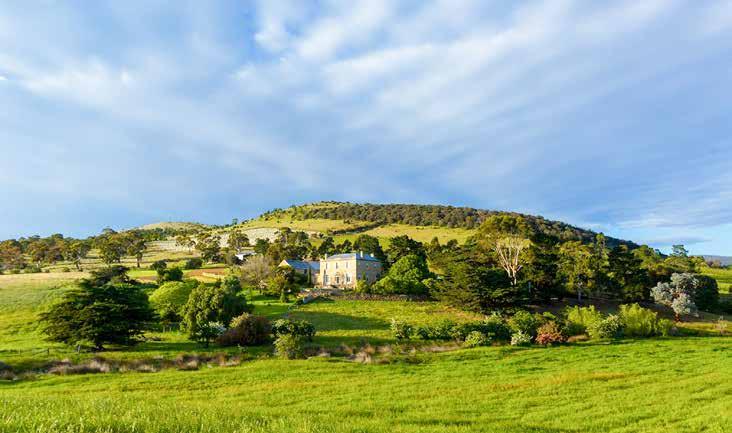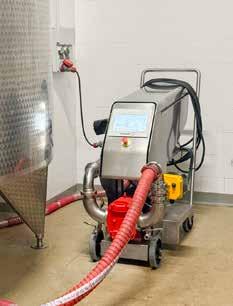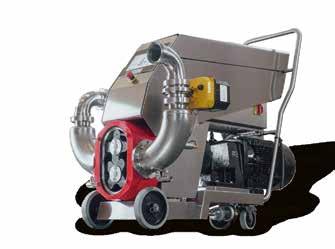

THE NEED TO REFOCUS AUSSIE WINE



Cover:
Our November issue of Grapegrower & Winemaker looks ahead to the vintage to come, and the positioning of the Australian wine. Wine critic and author Jeremy Oliver takes a close look and a red pen to Australian industry, and we dive into the latest data to unpack export sales and grape price expectations. Writer Timothey Giles explores uncompromising vineyard expansion in New Zealand, whilst Brendan Black investigates the potential for wine on tap, and Ian Jeffery considers intelligent power usage for winery fridges. Photo: ‘The Hand in the Vat’ by Franck Tremblay, a winner of the World Food Photography Awards .

NEWS
7 NZ Winegrowers annual report highlights sustainability as a key to success
8 Tasmania’s wine industry a “strong performer”
6 What’s online
6 In this issue
14 My View: Change for Aussie wine is “necessary and inevitable”
17 Winetitles Analytics: GrapeCheck
24 International briefs
82 Producer Profile: Trina Smith
84 Looking Back
84 Calendar
85 Marketplace classifieds

10 Yarra Valley breaks Tasmania’s fiveyear streak at the Australian Pinot Noir Challenge
11 Australian wine to benefit from organics agreement with Japan
12 2025 Royal Adelaide Wine Show winners named
13 “Local hero” Peter Gago named a Legend of the Vine
20 Exports to mainland China plateau after initial re-stocking period
GRAPEGROWING
25 FEATURE Beneath the vine: Measuring and managing soil health
30 Kumeū River - Growing their future
36 Tas wine sector announces sustainability awards as 2025 environmental sustainability report released
38 Report examines future of the Limestone Coast wine industry
WINEMAKING
48
FEATURE Pumping up performance: Achieving smarter, cleaner flow in the winery
52 Refrigeration smarts: Intelligent usage to achieve power savings
56
FEATURE Bottling and beyond: Enhancing performance across the winery
BUSINESS & TECHNOLOGY
66
Treasury Wine Estates releases major sustainability report
68 Toolkit released to advance gender equity across wine sector
SALES & MARKETING
70 Common breaches of alcohol advertising guidelines
72
FEATURE Tapping into the potential of wine by the glass
76 Bulk balance: Navigating the global bulk wine market
80 Finalists revealed for Wine Industry Impact Awards


NZ Winegrowers annual report highlights sustainability as a key to success
This year marks the 30th anniversary of Sustainable Winegrowing New Zealand, an industry led, independently audited, sustainability certification programme. In its 2025 annual report, sustainability has been identified by New Zealand Winegrowers as “a key differentiator for New Zealand wine’s reputation”. The industry body says that reputation has lifted exports to over NZ$2.10 billion per annum.
According to New Zealand Winegrowers, success has fuelled investment in 42,000 hectares of vineyards across regional New Zealand, state-of-the-art processing facilities, and strong brands that “proudly bear New Zealand on the label”. Wine from New Zealand is now exported to over 100 countries, with 90 per cent of wine produced heading to global markets.
While the industry has many positives, New Zealand Winegrowers chair Fabian Yukich outlined challenges in the report.
“A strong reputation and in-market performance ahead of competitors are real positives on which to build for the future, however, producers are currently navigating their way through a complex and uncertain business environment.
“Much of the current focus of industry activity is on the immediate challenges confronting growers and wineries. Market and economic developments are compounding industry-specific issues to create a highly uncertain environment”, he said.
Despite imposition of the higher tariffs late in the year, the major market for New Zealand wine remains the USA with exports valued at NZ$762 million, down 3% in the past year. While the increased tariffs have been in place since April with a further increase in August, it is not yet possible to discern the effect of these in the export data.
The strongest growth in the past year has been from emerging export destinations. Shipments to China grew 47% to $56 million, while exports to South Korea lifted 92% to $44 million. Overall exports to second-tier markets (all those except the UK, USA and Australia, which take over 70% of New Zealand’s exports) grew 17% in the past 12 months to just under $600 million. This reflects strong trade and consumer interest as well as the ability of wineries to develop new markets with improved supply. According to market researcher IWSR,
lighter refreshing styles are outpacing overall wine category performance. This shift is driven by varietals with more refreshing palate profiles, which New Zealand excels in delivering.
Vintage 2025
Favourable weather conditions in the run-up to vintage 2025 delivered a crop that would have significantly exceeded any previous vintage in New Zealand’s history. Throughout the country, vintage weather was marked by warm, dry days and cool nights—positive conditions for a high-quality harvest. Against the backdrop of an uncertain demand outlook, it was unsurprising that wineries limited their grape intake.
Concluding the annual report, Yukich provided an outlook for the industry.
“While much has changed since 2020, the fundamentals that have made New Zealand wine successful over the past three decades have not. Success in the future will reflect this: we must continue to produce highly distinctive, premium and sustainable wines that are an enduring reflection of New Zealand and its people”.
Image courtesy NZ Winegrowers

Tas wine sector announces sustainability awards in conjunction with 2025 sustainability report
At last month’s Tassie Wine Stars event, Pooley Wines in the Coal River Valley was announced as the 2025 VinØ (‘vin zero’) Program Champion and Eversley Vines in the Tamar Valley was awarded the 2025 VinØ Program’s Most Improved Producer.
Wine Tasmania’s viticulture and winemaking officer, Paul Smart, said that the tailored and voluntary VinØ Program helps the island’s wine producers produce highquality wine without negative impacts on the environment or local communities.
“Tasmania launched its VinØ Program in 2015, and we have continued to see improved sustainability practices across participating wine businesses over the past decade as a result”, Smart said.
“The VinØ Program is a comprehensive but easy-to-use program, which helps wine businesses of all sizes move towards best practice. This year sees the highest aggregated score of the VinØ Program to date, reflecting the continuing improvement of participating wine businesses. The VinØ Program is tailored for Tasmanian wine businesses and aligns with our customer expectations around sustainability practices. It is reviewed
and updated annually, with the 2026 program including new Environmental, Social and Governance (ESG) metrics aligned to the Australian Agricultural Sustainability Framework.”
Viticulturalist for Pooley Wines in the Coal River Valley, Steve Ferguson, said it was the fourth time the business had been named VinØ Program Champion.
“Our results at Pooley Wines reflect the long-term dedication of the owners, John and Libby Pooley, to be one of the most sustainable wine producers in Tasmania. The support of general manager Tristan Jones, and the rest of the Pooley team have greatly contributed to our success in this area. To have now won the VinØ Program Champion award four times is very satisfying”, he said.
Shelley and Matthew Grant, owners of Eversley Vines in the Tamar Valley, were on hand to collect the 2025 VinØ Program Most Improved Producer Award.
“We are so honoured to receive the VinØ Most Improved Producer Award. As a small-scale producer focused on a regenerative approach to vineyard management, we have found the VinØ framework to be invaluable in identifying opportunities for change, measuring progress and shaping our practices to ensure continual improvement. This recognition belongs to everyone who puts their hands and hearts into this humble vineyard and celebrates a Tasmanian wine community which is united by sustainability, quality, and excellence.” said Shelley.
The full 2025 VinØ Program Report is available to download: www. winetasmania.com.au/vinzero2025
An overview of the VinØ Program is available online: www.winetasmania. com.au/vinzerolookingaftertheland
Pooley Wines’ Butcher’s Hill vineyard in the Coal River Valley. Image courtesy Pooley Wines
Vogelsang Wine Pump
Leading by innovation
In the world of winemaking, precision, care, and consistency define quality. Vogelsang understands that each drop of wine deserves gentle handling — from the vineyard to the barrel. That’s why the Vogelsang Wine Pump has been engineered to combine intelligent control with gentle performance, ensuring your wine retains its integrity at every stage of production.
Gentle product handling
Designed for gentle product handling, the Vogelsang Wine Pump uses rotary lobe technology to move wine efficiently without compromising aroma, flavour, or texture. Its pressure-controlled operation provides smooth, even flow — ideal for delicate varietals and premium wines.
Intelligent automation
Modern wineries demand both precision and simplicity. The Vogelsang Wine Pump delivers with automated pumpover cycles and automated barrel filling, reducing manual intervention and improving repeatability. Builtin overheating protection safeguards
both product and equipment, allowing operators to focus on what matters most — crafting exceptional wine.
Smart connectivity
Ease of operation takes centre stage with smart connectivity via iOS or Android apps, enabling full control and monitoring right from your mobile device. For even greater flexibility, optional remote control and integrated flow metering can be added to suit any winery’s needs.
Whether for boutique operations or largescale production, Vogelsang continues to set the standard in pump technology. Reliable, intelligent, and designed for winemakers who demand the best — Vogelsang truly is leading by innovation.


QUALITY UNCORKED
Gentle wine processing with the new Vogelsang wine pump

Flexibility is the name of the game. Vogelsang pumps for the wine industry are used successfully in all stages of wine production: from delivery to bottling. The quality of the product remains unchanged and oxygenation is reduced to maintain integrity of the flavours. Vogelsang pumps are particularly valued for being pulsation-free and self-priming as well as low maintenance, making them the perfect choice for wineries of all sizes.
VOGELSANG – LEADING IN TECHNOLOGY vogelsang.info

Winery Pumps

Treasury Wine Estates’ major sustainability report
Treasury Wine Estates (TWE) has released its ‘Cultivating a Brighter Future’ report, outlining the wine producer’s progress against its sustainability agenda.
The new report features adaptation and mitigation projects including on-site solar systems across its global vineyards and production facilities, as well as electric vehicle charging, alternative fuel transition, water preservation, sustainability certification and process automation projects.
Chief supply and sustainability officer Kerrin Petty said sustainability was core to TWE’s global operations.
“The changing climate presents challenges for all agricultural businesses, and our ongoing investment represents our long-term commitment to sustainability in wine production,” Petty said.
“We’ve been custodians of some of the world’s best viticultural assets for almost two centuries, so continuing to care for the environment for generations to come is a natural progression. In this decade of action, it’s critical that industry, government and academic institutions come together to respond to challenges.”
Future projects aim to mitigate risk and adapt to the changing climate over the short term, including smart meter installation and building climate control, complemented by longer-term initiatives including water security, vineyard management practices and redevelopment, and growing region expansion.
We’ve been custodians of some of the world’s best viticultural assets for almost two centuries, so continuing to care for the environment for generations to come is a natural progression.
Kerrin Petty
Solar installation at Coldstream Hills in the Yarra Valley
